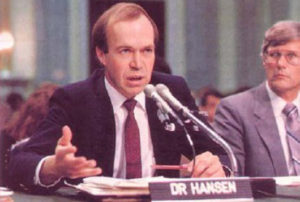by WorldTribune Staff, June 25, 2018
In the summer of 1988, NASA scientist James Hansen issued sounded the alarm on global warming.

In testimony before the Senate Committee on Energy and Natural Resources, Hansen expressed a “high degree of confidence” in “a cause-and-effect relationship between the greenhouse effect and observed warming.”
With his testimony, Hansen “lit the bonfire of the greenhouse vanities, igniting a world-wide debate that continues today about the energy structure of the entire planet,” Pat Michaels and Ryan Maue wrote in a June 21 analysis for the Wall Street Journal.
Michaels is director and Maue an adjunct scholar at the Cato Institute’s Center for the Study of Science.
Hansen told the Senate of three possible scenarios for the future of carbon dioxide emissions:
- Scenario A was “business as usual,” as it maintained the accelerating emissions growth typical of the 1970s and ’80s. This scenario predicted the earth would warm 1 degree Celsius by 2018.
- Scenario B set emissions lower, rising at the same rate today as in 1988. Hansen called this outcome the “most plausible,” and predicted it would lead to about 0.7 degree of warming by 2018.
- Scenario C, which Hansen deemed highly unlikely: constant emissions beginning in 2000. In that forecast, temperatures would rise a few tenths of a degree before flatlining after 2000.
Michaels and Maue note that, in the 30 years of data that have been collected since Hansen outlined his scenarios, “the winner is Scenario C. Global surface temperature has not increased significantly since 2000, discounting the larger-than-usual El Niño of 2015-16. Assessed by Hansen’s model, surface temperatures are behaving as if we had capped 18 years ago the carbon-dioxide emissions responsible for the enhanced greenhouse effect. But we didn’t.”
Michaels and Maue continued: “And it isn’t just Hansen who got it wrong. Models devised by the United Nations Intergovernmental Panel on Climate Change have, on average, predicted about twice as much warming as has been observed since global satellite temperature monitoring began 40 years ago.”
What about Hansen’s other claims?
“Outside the warming models, his only explicit claim in the testimony was that the late ’80s and ’90s would see ‘greater than average warming in the southeast U.S. and the Midwest.’ No such spike has been measured in these regions,” Michaels and Maue wrote.
Have hurricanes gotten stronger, as Hansen predicted in a 2016 study? “No. Satellite data from 1970 onward shows no evidence of this in relation to global surface temperature,” Michaels and Maue noted.
Have storms caused increasing amounts of damage in the U.S.? “Data from the National Oceanic and Atmospheric Administration show no such increase in damage, measured as a percentage of gross domestic product,” Michaels and Maue wrote.
How about stronger tornadoes? “The opposite may be true, as NOAA data offers some evidence of a decline. The list of what didn’t happen is long and tedious,” Michaels and Maue wrote.
Michales and Maue conclude: “On the 30th anniversary of Hansen’s galvanizing testimony, it’s time to acknowledge that the rapid warming he predicted isn’t happening. Climate researchers and policy makers should adopt the more modest forecasts that are consistent with observed temperatures. That would be a lukewarm policy, consistent with a lukewarming planet.”
Subscribe to Geostrategy-Direct __________ Support Free Press Foundation
